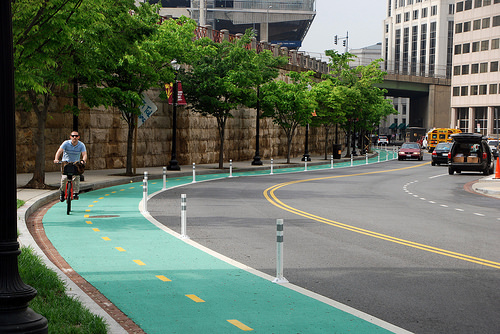“Cycletrack”? “Protected bike lane”? What do you call them?
Those bicycle lanes with a physical barrier between the lane and other road users have been appearing around the region: 15th, L, and M streets NW and 1st Street NE in DC, Hayes Street in Arlington, and Woodglen Drive in White Flint. What should we call these?
Greater Greater Washington’s current style has been to say “cycletrack.” But Streetsblog, the Green Lane Project, and WABA all have decided in recent years to call them “protected bike lanes.” In its new bike plan, Fairfax County calls them “separated bike lanes.”
The contributors recently discussed the pros and cons. Here are some of the top arguments. What do you think? You can vote using the poll at the bottom of this post.
Arguments for and against “cycletrack”
“Cycletrack” is short and to the point. It’s pretty easy to remember. The National Association of City Transportation Officials (NACTO) calls these “cycle tracks.” Since we’ve been using that term, continuing would make posts consistent and avoid confusing anyone with a change.
On the other hand, the term sounds like it’s a place for cyclists to speed (in the same way a running track is a place to run as fast as possible). This isn’t a velodrome, but a transportation facility. The Green Lane Project quotes several experts who said “cycletrack” confused some laypeople and sounded too “sporty.”
Arguments for and against “protected bike lane”
The main reason these facilities are better than the standard painted bike lane is that they protect cyclists from motor vehicle traffic. Cyclists feel (and most experts believe they are) safer thanks to this protection. So this name puts front and center the feature that is its main selling point: its protection.
In choosing this, the Green Lane Project also pointed out that “protected bike lane” clearly conveys that “they’re just for bikes and they’re part of the roadway,” and that it’s easy to modify, like “curb-protected bike lane” for one that has a curb between it and the other lanes.
One disadvantage: It’s a lot longer. It’s three words instead of one, 19 characters instead of 10, five syllables instead of three (and the middle one very short).
Jim Titus also noted that one problem with “protected bike lane” (or “separated bike lane”) is that in Maryland, there’s a legal definition of a bike lane that doesn’t encompass these facilities. Further, he wrote, in Maryland “cyclists are required to ride in bike lanes even if they are traveling at the speed of other vehicles.” Not calling it a kind of bike lane can emphasize the difference.
However, I’m not sure that is a reason to pick a name. The legal rule for when you have to ride in a bike lane applies only to things that meet the legal definition of a bike lane. So the fact that the definition doesn’t encompass these means the limitations also don’t apply. Just because we call it a “protected bike lane” won’t make the law any different.
Arguments for and against “separated bike lane”
“Separated bike lane” emphasizes the physical differences, that there’s a separation.
However, one danger with this is that some bike lanes have a separation of distance (such as with a painted buffer zone) but no other features. NACTO calls those “buffered bike lanes.” Is there enough of a clear distinction between “separated” and “buffered”?
The Green Lane Project further noted that “the word ‘separated’ carried a negative connotation” in surveys, and “protected bike lane” appears 3½ times as often as “separated bike lane” in news mentions.
What do you think? Vote in the poll below, then give your reasons in the comments. Or if you have another idea, put it on the poll and also explain it in the comments. If you’re okay with more than one, you can select multiple.
We’re going to decide based on the strength of arguments as well as on the vote, not just blindly picking the one that wins, so please do give your reasons in the comments.
Update: I had to delete the poll because it was causing a cache problem in Chrome, where voting and then later going to our home page would redirect to the poll site. If this is happening to you, clear your Chrome cache. I’ll get a new poll up soon. You can now vote on this Google Form. It won’t show the tally, but I’ll follow up with a post giving the results.

